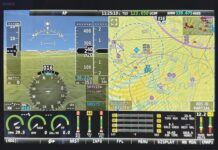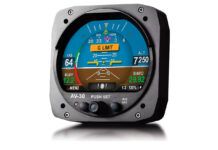By now, the Apple iPad has established itself as a strong utility player in many aircraft, most often running as a so-called electronic flight bag (EFB) to display moving maps, charts, weather and traffic. But Falken Avionics’ Flight View system has a different take on putting Apple’s tablet to use—as a primary instrument.
What that requires, of course, is a way to get aircraft data into the iPad itself. Typically, this happens one of three ways—through Bluetooth, Wi-Fi or a wired connection—plus you have to generate the aircraft-position data in the first place. This is where the Falken FDC (flight data computer) comes in. The FDC includes a VFR GPS, pitot/static sensors, an AHRS module, an ADS-B In module and ports for controlling external devices such as a com radio or transponder. Also inside the FDC is an Ethernet network that can be used to maintain a wired connection (that also includes charging) for the iPads, though they can also connect via Wi-Fi. In this sense, the iPads become a wired part of the FDC ecosystem.
Another must-have option is the FlightBar. Mating to the surface iPad mount, the FlightBar provides six pushbutton switches and two knobs with simple push-to-change functions. The buttons are tactile enough but the knobs are pleasingly solid and precise. Pushing on the knobs changes the menu selection on the screen. It acts similarly to Dynon’s arrangement that changes the knob’s function so you can set the barometric pressure or heading bugs, for example. For their part, the buttons correspond to dynamic menus along the bottom of the iPad display. Normally, they are, left to right, autopilot, transponder, com radio, engine monitoring and “more.” Selecting any of these menu items will bring up a special half screen (moving the primary flight display over to a half-size display if you’ve been using it in full-screen mode) with, for example, a quick pad entry for transponder mode and squawk as well as direct frequency entry for the com radio.
Aren’t iPads known for running hot and needing external cooling? Yes and yes. Falken thought of this, with the standard arrangement, a simple cooling fan that fits through a 3-1/8-inch instrument hole. It’s possible to upgrade to the Falken TEC cooling system, a thermoelectric block that also fits through an instrument hole. The cold plate protrudes through the panel and contacts the back of the iPad in the holder. Other than a hidden panel hole, there’s not much to the physical installation since the mounts attach to the front side of the panel.
I had a brief flight with Falken’s founder Steve Sokol in his Van’s RV-6A. He was testing two large screen iPads (the standard iPad with the 10.9 inch screen) and one iPad mini in the center running the new standalone engine-monitoring package. (This allows you to install the EMS module, sensor and probes, and talk to the display via Bluetooth in such a way that you can also run an EFB like ForeFlight in split-display mode.) In Sokol’s airplane, the FlightView system was connected to a remote com radio and transponder, had a connection to a TruTrak autopilot and one more to the Garmin GPS 175 navigator.
For much of the flight, I focused on the full-screen PFD with a smaller inlaid moving map—the ForeFlight map on the center screen was doing most of the navigation work. First impressions are good. For one, FlightView does not have synthetic vision, so the display itself, with a muted blue above the horizon and a similarly muted brown below it, was easy to read. There is good detail in the iPad, which intrinsically has a lot more resolution than most aviation EFISes, optimized with careful gradients and thin lines to provide clear demarcation. For their part, the iPads were plenty bright on an overcast day under a canopy. At the top of the attitude indicator portion is a slip/skid display under the bank-angle pointer, making it more like a Garmin G1000 than a G3X or Dynon SkyView, which have representations more like a standard tube-and-ball we all grew up with.
It was relatively turbulent the day we flew, but the FlightView AHRS did well. Moreover, it’s nicely damped so that the display reveals very little jitter as it accurately follows what the airplane is actually doing. Those knobs and buttons along the lower edge are worth every penny in cobbly air, too, although there’s a small ledge along the top edge of the iPad screen to make it somewhat easier to use the touchscreen functions in turbulence.
The EMS is displayed along the bottom edge and consists of capsule-style tape displays bracketed by the value and/or reading type. At first glance, they seem a lot the same but color coding helps a lot—if everything’s green, all is well—but the EGT and CHT bars are nicely separated from the oil (pressure and temperature) readings and the fuel and electrical over on the right side. Engine speed and manifold pressure are over on the left. Ghosted icons on the right edge of the screen allow access to other screen styles and functions, including the moving map and a checklist set.
From a software standpoint, the FlightView system seems fully baked. But there are functions yet to come. For example, Sokol is working on an ARINC 429 adapter (due late summer or fall) that would allow the system to display vertical and lateral guidance from an IFR GPS. The system does not yet have a dedicated magnetometer system, so any heading displayed will be ground track from the GPS.
Falken also has the FlightBox Pro available. This is a standalone GPS/AHRS module with a dual-frequency ADS-B module and a built-in altimeter (no pitot input, though). Think of this as a permanent-mount Sentry to provide data to an EFB.
Prices range from $2495 for a single-screen system with one FDC and range upward to $5995 for a three-screen system that also includes the iPads and the engine monitoring module (but not probes). Options include the $250 FlightBar and the engine monitoring box for $895 as well as several data-connection cable sets. The FlightBox Pro is also $895.
More information: falkenavionics.com




















